Domestic Violence Assignment PDF
VerifiedAdded on 2021/08/03
|20
|6314
|350
AI Summary
Contribute Materials
Your contribution can guide someone’s learning journey. Share your
documents today.
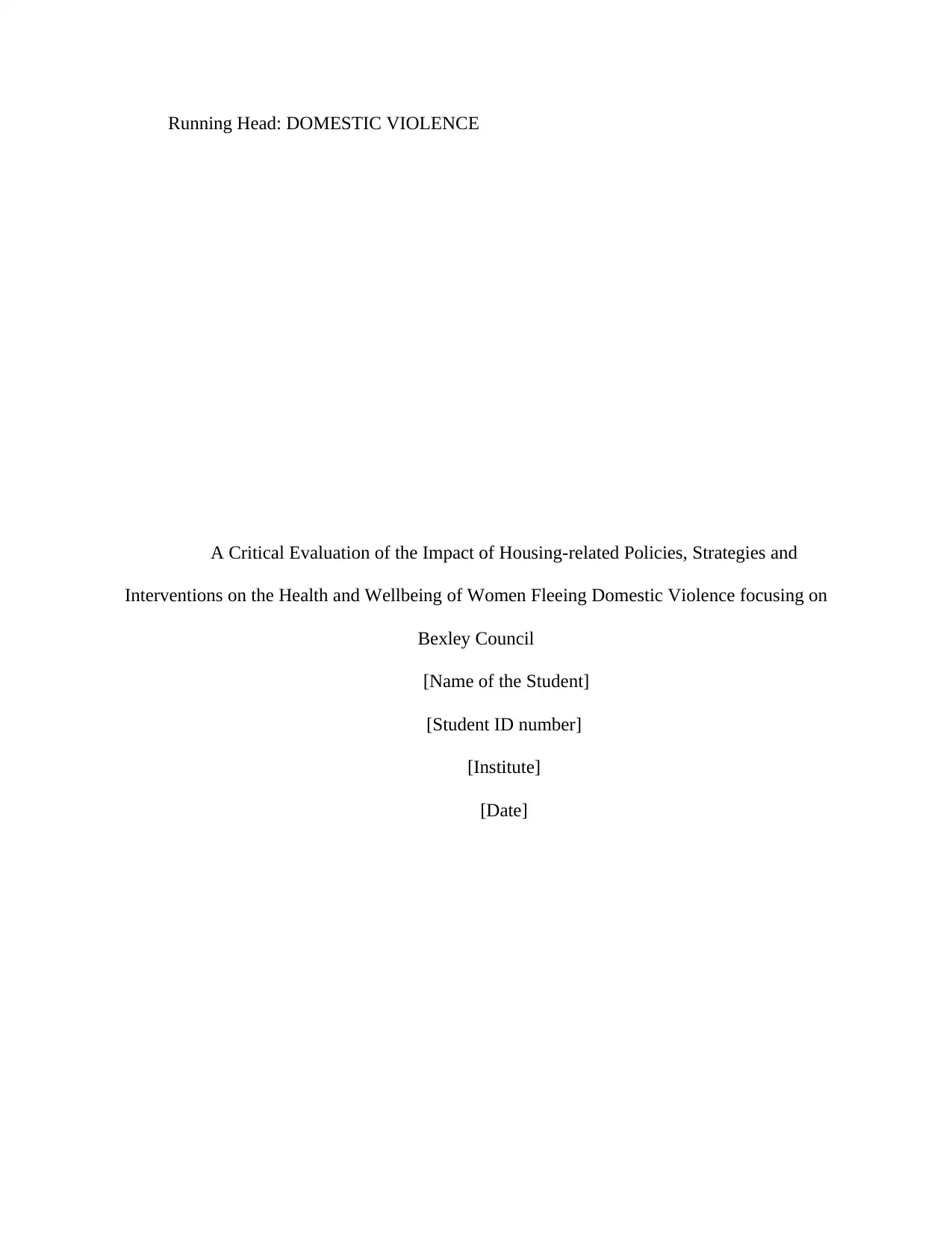
Running Head: DOMESTIC VIOLENCE
A Critical Evaluation of the Impact of Housing-related Policies, Strategies and
Interventions on the Health and Wellbeing of Women Fleeing Domestic Violence focusing on
Bexley Council
[Name of the Student]
[Student ID number]
[Institute]
[Date]
A Critical Evaluation of the Impact of Housing-related Policies, Strategies and
Interventions on the Health and Wellbeing of Women Fleeing Domestic Violence focusing on
Bexley Council
[Name of the Student]
[Student ID number]
[Institute]
[Date]
Secure Best Marks with AI Grader
Need help grading? Try our AI Grader for instant feedback on your assignments.

Domestic Violence 2
Table of Contents
Table of Contents

Domestic Violence 3
A Critical Evaluation of the Impact of Housing-related Policies, Strategies and
Interventions on the Health and Wellbeing of Women Fleeing Domestic Violence focusing on
Bexley Council
Introduction
Every week in the UK, two women are killed by their husbands, ex-spouses or
partners. According to the Ministry of the Interior, 1.2 million women reported domestic
violence last year, with two out of three not the first. But in fact, there are much more of
them. According to a study by the local organization Council for Citizens, more than half a
million victims of domestic violence prefer not to report their misfortune, as they are
extremely frightened.
Terrifying statistics are aggravated by another problem: a woman who announced that
her husband beats her must divorce him, otherwise in the future her children may be taken
away by the guardianship authorities.
According to the Guardian newspaper, victims of violence are increasingly hearing this
from social workers. As a result, if a wife is not ready to leave her beating spouse, she
deliberately hides her problems from others. In addition, according to the British family rights
group, as a result of the recent reform of the social security system, many families have lost
the opportunity to seek qualified help. It has become more difficult for victims of violence to
obtain temporary shelter and security guarantees from the state, as well as treatment for
perpetrators.
Increasingly, it happens that help comes only when the situation goes too far, and the
intervention of emergency services is required. Community organizations and foundations
A Critical Evaluation of the Impact of Housing-related Policies, Strategies and
Interventions on the Health and Wellbeing of Women Fleeing Domestic Violence focusing on
Bexley Council
Introduction
Every week in the UK, two women are killed by their husbands, ex-spouses or
partners. According to the Ministry of the Interior, 1.2 million women reported domestic
violence last year, with two out of three not the first. But in fact, there are much more of
them. According to a study by the local organization Council for Citizens, more than half a
million victims of domestic violence prefer not to report their misfortune, as they are
extremely frightened.
Terrifying statistics are aggravated by another problem: a woman who announced that
her husband beats her must divorce him, otherwise in the future her children may be taken
away by the guardianship authorities.
According to the Guardian newspaper, victims of violence are increasingly hearing this
from social workers. As a result, if a wife is not ready to leave her beating spouse, she
deliberately hides her problems from others. In addition, according to the British family rights
group, as a result of the recent reform of the social security system, many families have lost
the opportunity to seek qualified help. It has become more difficult for victims of violence to
obtain temporary shelter and security guarantees from the state, as well as treatment for
perpetrators.
Increasingly, it happens that help comes only when the situation goes too far, and the
intervention of emergency services is required. Community organizations and foundations

Domestic Violence 4
come to the aid of victims of domestic violence. In Britain there are "hot lines" not only for
women and children, but also for men who have suffered from domestic violence, there are
services that deal with similar cases in same-sex unions.
Experts consider this to be an important issue, as domestic violence is rarely limited to
a single incident. But at the end of last year it became known that the British Parliament is
going to change the criminal law so that domestic violence becomes a separate category of
crimes with punishment up to 14 years in prison.
The British police will be able to track the behavior of a domestic tyrant after the first
recorded incident, as well as introduce measures to protect the victim from his
attacks. According to British media reports, the law is expected to receive broad support in
parliament and be passed.
Discussion
In the UK, the National Domestic Abuse helpline has seen a 25% increase in web calls
and reports since lockdown began. This translates to hundreds of more calls last week compared
to previous weeks, reports to the BBC the association which manages this line. The number
of visitors to the association's site has also increased significantly, with 150% more visits
compared to the last week of February.
Domestic Violence Against Women
Many believe that domestic violence against women and children is related to physical
abuse, that is, beatings. However, the concept of domestic violence is much broader and does not
necessarily consist only of beatings and scandals. People around you may not even notice that
come to the aid of victims of domestic violence. In Britain there are "hot lines" not only for
women and children, but also for men who have suffered from domestic violence, there are
services that deal with similar cases in same-sex unions.
Experts consider this to be an important issue, as domestic violence is rarely limited to
a single incident. But at the end of last year it became known that the British Parliament is
going to change the criminal law so that domestic violence becomes a separate category of
crimes with punishment up to 14 years in prison.
The British police will be able to track the behavior of a domestic tyrant after the first
recorded incident, as well as introduce measures to protect the victim from his
attacks. According to British media reports, the law is expected to receive broad support in
parliament and be passed.
Discussion
In the UK, the National Domestic Abuse helpline has seen a 25% increase in web calls
and reports since lockdown began. This translates to hundreds of more calls last week compared
to previous weeks, reports to the BBC the association which manages this line. The number
of visitors to the association's site has also increased significantly, with 150% more visits
compared to the last week of February.
Domestic Violence Against Women
Many believe that domestic violence against women and children is related to physical
abuse, that is, beatings. However, the concept of domestic violence is much broader and does not
necessarily consist only of beatings and scandals. People around you may not even notice that
Secure Best Marks with AI Grader
Need help grading? Try our AI Grader for instant feedback on your assignments.
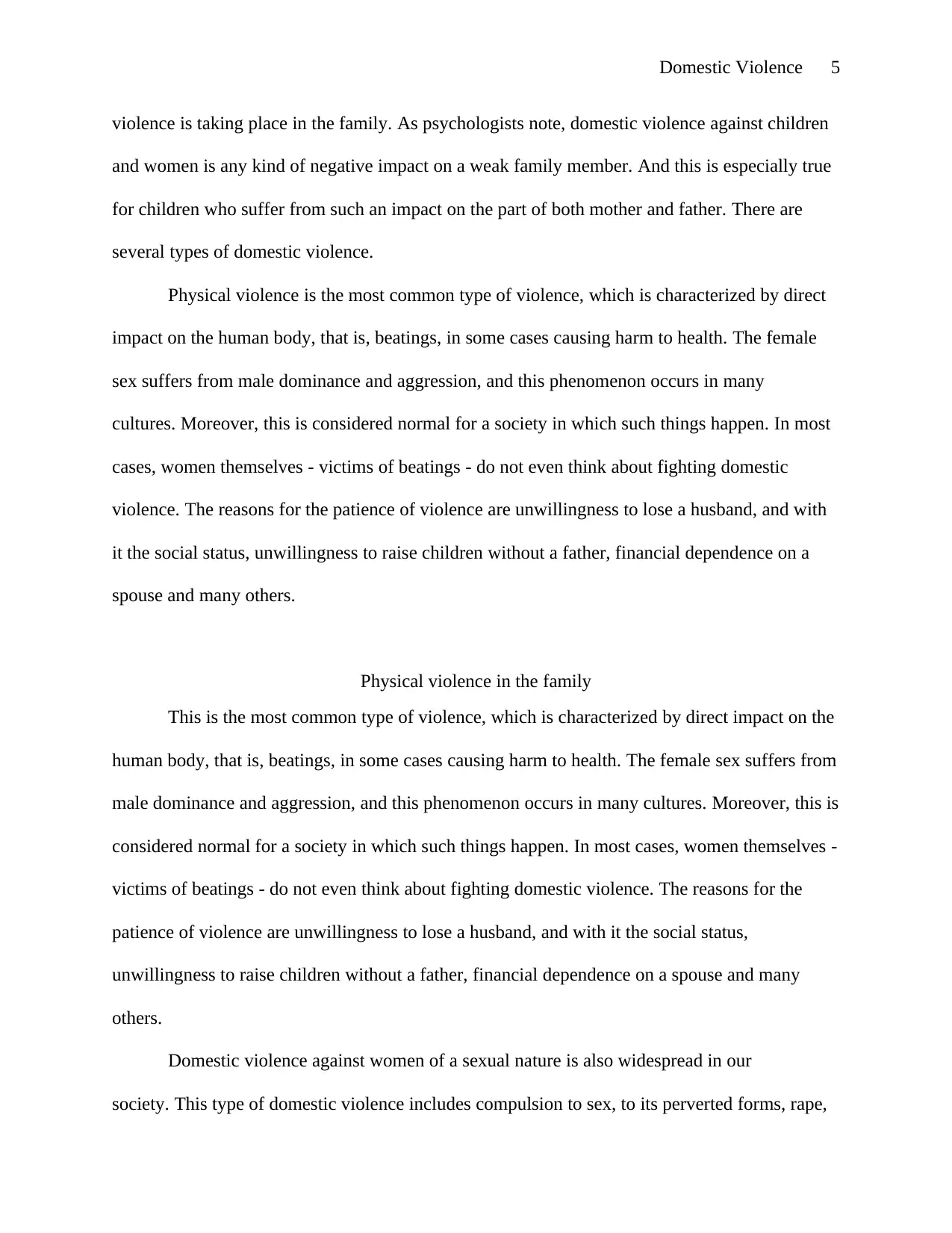
Domestic Violence 5
violence is taking place in the family. As psychologists note, domestic violence against children
and women is any kind of negative impact on a weak family member. And this is especially true
for children who suffer from such an impact on the part of both mother and father. There are
several types of domestic violence.
Physical violence is the most common type of violence, which is characterized by direct
impact on the human body, that is, beatings, in some cases causing harm to health. The female
sex suffers from male dominance and aggression, and this phenomenon occurs in many
cultures. Moreover, this is considered normal for a society in which such things happen. In most
cases, women themselves - victims of beatings - do not even think about fighting domestic
violence. The reasons for the patience of violence are unwillingness to lose a husband, and with
it the social status, unwillingness to raise children without a father, financial dependence on a
spouse and many others.
Physical violence in the family
This is the most common type of violence, which is characterized by direct impact on the
human body, that is, beatings, in some cases causing harm to health. The female sex suffers from
male dominance and aggression, and this phenomenon occurs in many cultures. Moreover, this is
considered normal for a society in which such things happen. In most cases, women themselves -
victims of beatings - do not even think about fighting domestic violence. The reasons for the
patience of violence are unwillingness to lose a husband, and with it the social status,
unwillingness to raise children without a father, financial dependence on a spouse and many
others.
Domestic violence against women of a sexual nature is also widespread in our
society. This type of domestic violence includes compulsion to sex, to its perverted forms, rape,
violence is taking place in the family. As psychologists note, domestic violence against children
and women is any kind of negative impact on a weak family member. And this is especially true
for children who suffer from such an impact on the part of both mother and father. There are
several types of domestic violence.
Physical violence is the most common type of violence, which is characterized by direct
impact on the human body, that is, beatings, in some cases causing harm to health. The female
sex suffers from male dominance and aggression, and this phenomenon occurs in many
cultures. Moreover, this is considered normal for a society in which such things happen. In most
cases, women themselves - victims of beatings - do not even think about fighting domestic
violence. The reasons for the patience of violence are unwillingness to lose a husband, and with
it the social status, unwillingness to raise children without a father, financial dependence on a
spouse and many others.
Physical violence in the family
This is the most common type of violence, which is characterized by direct impact on the
human body, that is, beatings, in some cases causing harm to health. The female sex suffers from
male dominance and aggression, and this phenomenon occurs in many cultures. Moreover, this is
considered normal for a society in which such things happen. In most cases, women themselves -
victims of beatings - do not even think about fighting domestic violence. The reasons for the
patience of violence are unwillingness to lose a husband, and with it the social status,
unwillingness to raise children without a father, financial dependence on a spouse and many
others.
Domestic violence against women of a sexual nature is also widespread in our
society. This type of domestic violence includes compulsion to sex, to its perverted forms, rape,
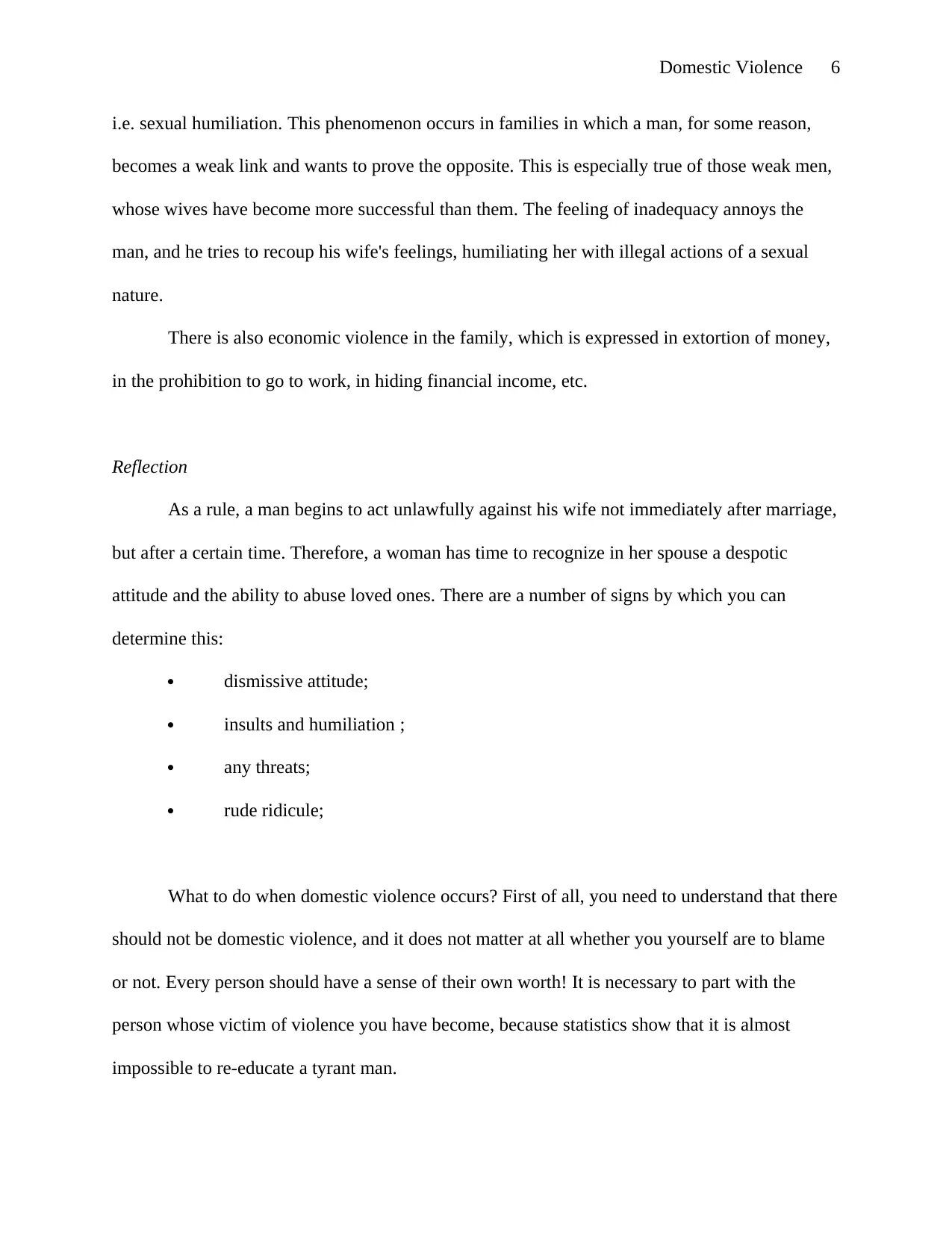
Domestic Violence 6
i.e. sexual humiliation. This phenomenon occurs in families in which a man, for some reason,
becomes a weak link and wants to prove the opposite. This is especially true of those weak men,
whose wives have become more successful than them. The feeling of inadequacy annoys the
man, and he tries to recoup his wife's feelings, humiliating her with illegal actions of a sexual
nature.
There is also economic violence in the family, which is expressed in extortion of money,
in the prohibition to go to work, in hiding financial income, etc.
Reflection
As a rule, a man begins to act unlawfully against his wife not immediately after marriage,
but after a certain time. Therefore, a woman has time to recognize in her spouse a despotic
attitude and the ability to abuse loved ones. There are a number of signs by which you can
determine this:
dismissive attitude;
insults and humiliation ;
any threats;
rude ridicule;
What to do when domestic violence occurs? First of all, you need to understand that there
should not be domestic violence, and it does not matter at all whether you yourself are to blame
or not. Every person should have a sense of their own worth! It is necessary to part with the
person whose victim of violence you have become, because statistics show that it is almost
impossible to re-educate a tyrant man.
i.e. sexual humiliation. This phenomenon occurs in families in which a man, for some reason,
becomes a weak link and wants to prove the opposite. This is especially true of those weak men,
whose wives have become more successful than them. The feeling of inadequacy annoys the
man, and he tries to recoup his wife's feelings, humiliating her with illegal actions of a sexual
nature.
There is also economic violence in the family, which is expressed in extortion of money,
in the prohibition to go to work, in hiding financial income, etc.
Reflection
As a rule, a man begins to act unlawfully against his wife not immediately after marriage,
but after a certain time. Therefore, a woman has time to recognize in her spouse a despotic
attitude and the ability to abuse loved ones. There are a number of signs by which you can
determine this:
dismissive attitude;
insults and humiliation ;
any threats;
rude ridicule;
What to do when domestic violence occurs? First of all, you need to understand that there
should not be domestic violence, and it does not matter at all whether you yourself are to blame
or not. Every person should have a sense of their own worth! It is necessary to part with the
person whose victim of violence you have become, because statistics show that it is almost
impossible to re-educate a tyrant man.
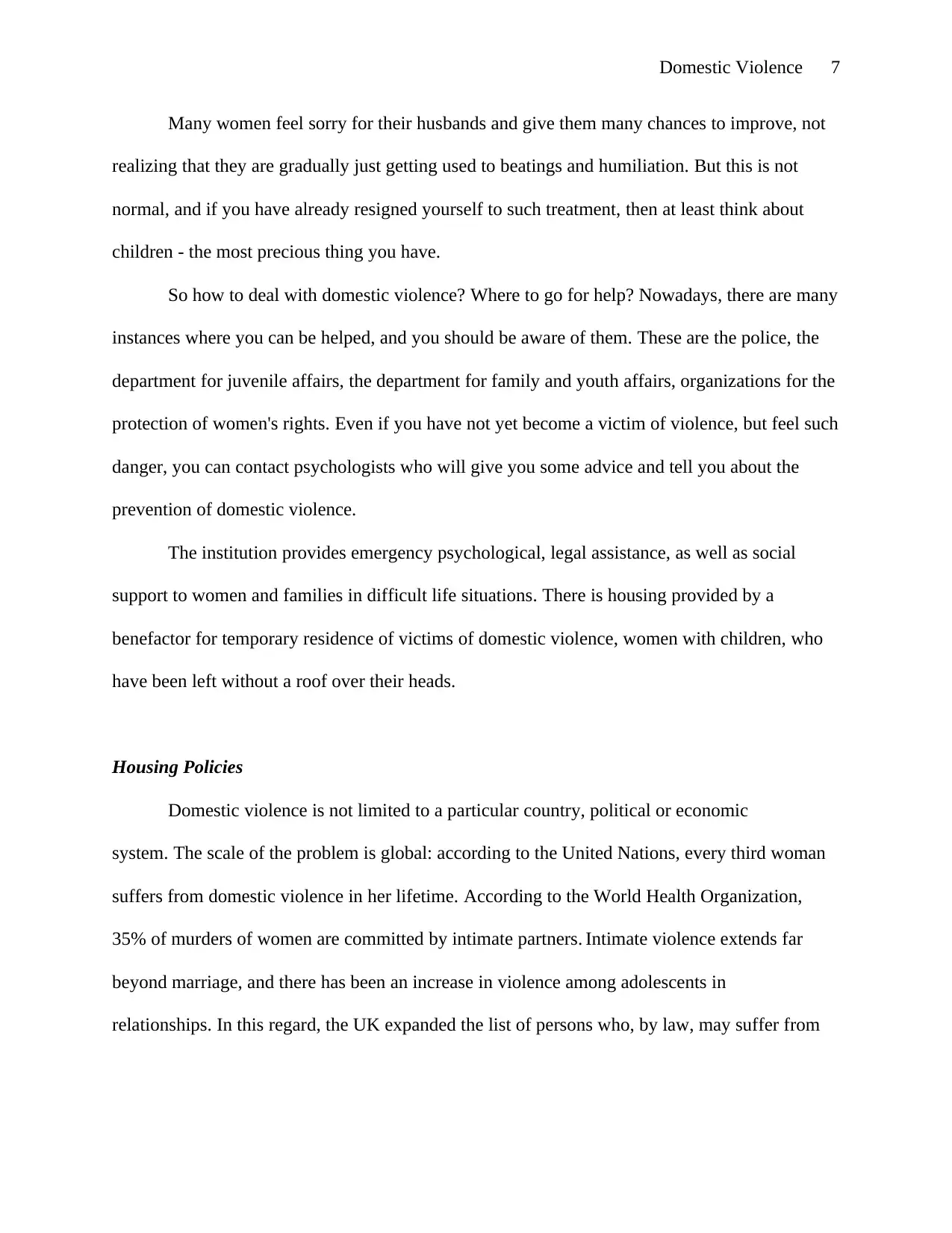
Domestic Violence 7
Many women feel sorry for their husbands and give them many chances to improve, not
realizing that they are gradually just getting used to beatings and humiliation. But this is not
normal, and if you have already resigned yourself to such treatment, then at least think about
children - the most precious thing you have.
So how to deal with domestic violence? Where to go for help? Nowadays, there are many
instances where you can be helped, and you should be aware of them. These are the police, the
department for juvenile affairs, the department for family and youth affairs, organizations for the
protection of women's rights. Even if you have not yet become a victim of violence, but feel such
danger, you can contact psychologists who will give you some advice and tell you about the
prevention of domestic violence.
The institution provides emergency psychological, legal assistance, as well as social
support to women and families in difficult life situations. There is housing provided by a
benefactor for temporary residence of victims of domestic violence, women with children, who
have been left without a roof over their heads.
Housing Policies
Domestic violence is not limited to a particular country, political or economic
system. The scale of the problem is global: according to the United Nations, every third woman
suffers from domestic violence in her lifetime. According to the World Health Organization,
35% of murders of women are committed by intimate partners. Intimate violence extends far
beyond marriage, and there has been an increase in violence among adolescents in
relationships. In this regard, the UK expanded the list of persons who, by law, may suffer from
Many women feel sorry for their husbands and give them many chances to improve, not
realizing that they are gradually just getting used to beatings and humiliation. But this is not
normal, and if you have already resigned yourself to such treatment, then at least think about
children - the most precious thing you have.
So how to deal with domestic violence? Where to go for help? Nowadays, there are many
instances where you can be helped, and you should be aware of them. These are the police, the
department for juvenile affairs, the department for family and youth affairs, organizations for the
protection of women's rights. Even if you have not yet become a victim of violence, but feel such
danger, you can contact psychologists who will give you some advice and tell you about the
prevention of domestic violence.
The institution provides emergency psychological, legal assistance, as well as social
support to women and families in difficult life situations. There is housing provided by a
benefactor for temporary residence of victims of domestic violence, women with children, who
have been left without a roof over their heads.
Housing Policies
Domestic violence is not limited to a particular country, political or economic
system. The scale of the problem is global: according to the United Nations, every third woman
suffers from domestic violence in her lifetime. According to the World Health Organization,
35% of murders of women are committed by intimate partners. Intimate violence extends far
beyond marriage, and there has been an increase in violence among adolescents in
relationships. In this regard, the UK expanded the list of persons who, by law, may suffer from
Paraphrase This Document
Need a fresh take? Get an instant paraphrase of this document with our AI Paraphraser
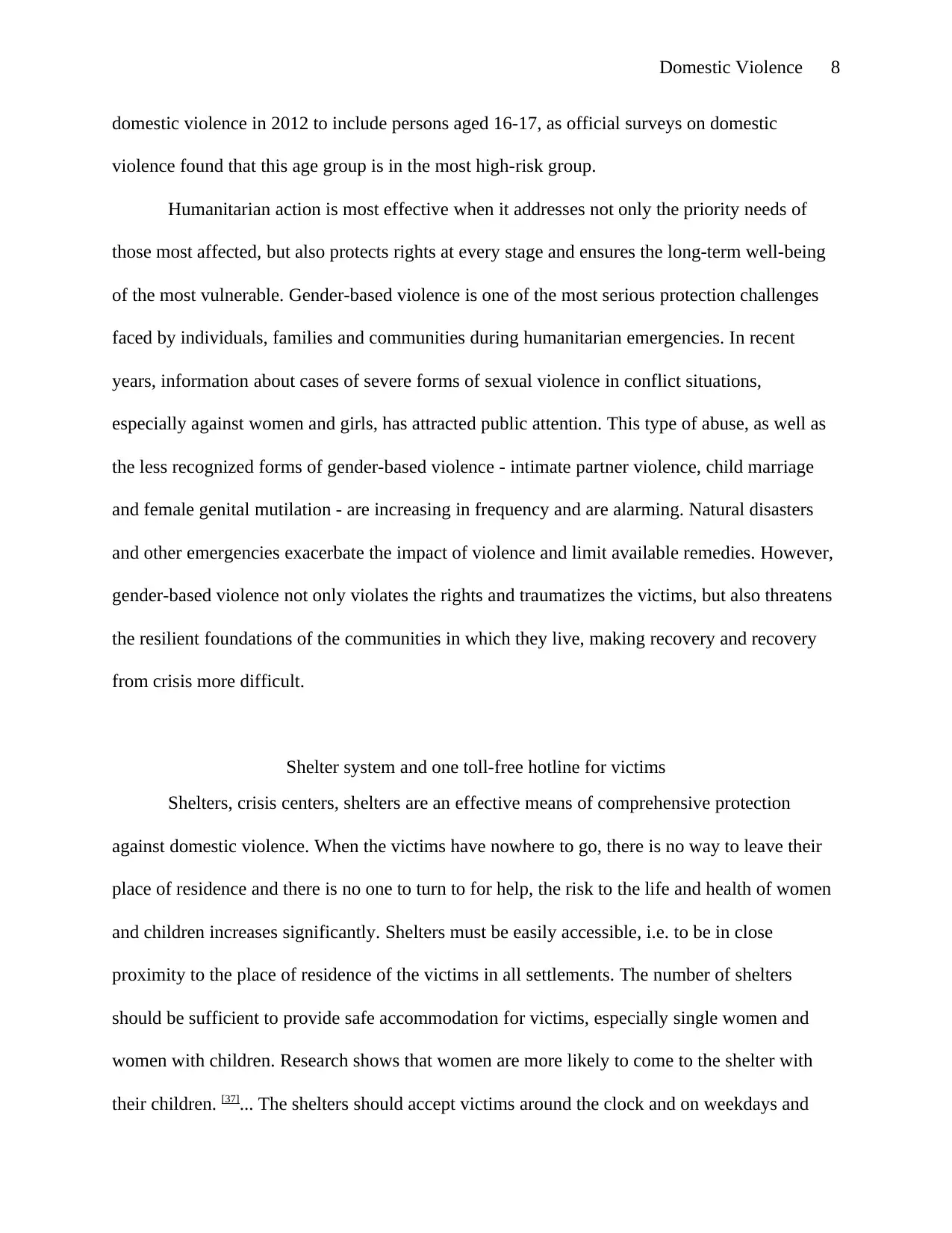
Domestic Violence 8
domestic violence in 2012 to include persons aged 16-17, as official surveys on domestic
violence found that this age group is in the most high-risk group.
Humanitarian action is most effective when it addresses not only the priority needs of
those most affected, but also protects rights at every stage and ensures the long-term well-being
of the most vulnerable. Gender-based violence is one of the most serious protection challenges
faced by individuals, families and communities during humanitarian emergencies. In recent
years, information about cases of severe forms of sexual violence in conflict situations,
especially against women and girls, has attracted public attention. This type of abuse, as well as
the less recognized forms of gender-based violence - intimate partner violence, child marriage
and female genital mutilation - are increasing in frequency and are alarming. Natural disasters
and other emergencies exacerbate the impact of violence and limit available remedies. However,
gender-based violence not only violates the rights and traumatizes the victims, but also threatens
the resilient foundations of the communities in which they live, making recovery and recovery
from crisis more difficult.
Shelter system and one toll-free hotline for victims
Shelters, crisis centers, shelters are an effective means of comprehensive protection
against domestic violence. When the victims have nowhere to go, there is no way to leave their
place of residence and there is no one to turn to for help, the risk to the life and health of women
and children increases significantly. Shelters must be easily accessible, i.e. to be in close
proximity to the place of residence of the victims in all settlements. The number of shelters
should be sufficient to provide safe accommodation for victims, especially single women and
women with children. Research shows that women are more likely to come to the shelter with
their children. [37]... The shelters should accept victims around the clock and on weekdays and
domestic violence in 2012 to include persons aged 16-17, as official surveys on domestic
violence found that this age group is in the most high-risk group.
Humanitarian action is most effective when it addresses not only the priority needs of
those most affected, but also protects rights at every stage and ensures the long-term well-being
of the most vulnerable. Gender-based violence is one of the most serious protection challenges
faced by individuals, families and communities during humanitarian emergencies. In recent
years, information about cases of severe forms of sexual violence in conflict situations,
especially against women and girls, has attracted public attention. This type of abuse, as well as
the less recognized forms of gender-based violence - intimate partner violence, child marriage
and female genital mutilation - are increasing in frequency and are alarming. Natural disasters
and other emergencies exacerbate the impact of violence and limit available remedies. However,
gender-based violence not only violates the rights and traumatizes the victims, but also threatens
the resilient foundations of the communities in which they live, making recovery and recovery
from crisis more difficult.
Shelter system and one toll-free hotline for victims
Shelters, crisis centers, shelters are an effective means of comprehensive protection
against domestic violence. When the victims have nowhere to go, there is no way to leave their
place of residence and there is no one to turn to for help, the risk to the life and health of women
and children increases significantly. Shelters must be easily accessible, i.e. to be in close
proximity to the place of residence of the victims in all settlements. The number of shelters
should be sufficient to provide safe accommodation for victims, especially single women and
women with children. Research shows that women are more likely to come to the shelter with
their children. [37]... The shelters should accept victims around the clock and on weekdays and
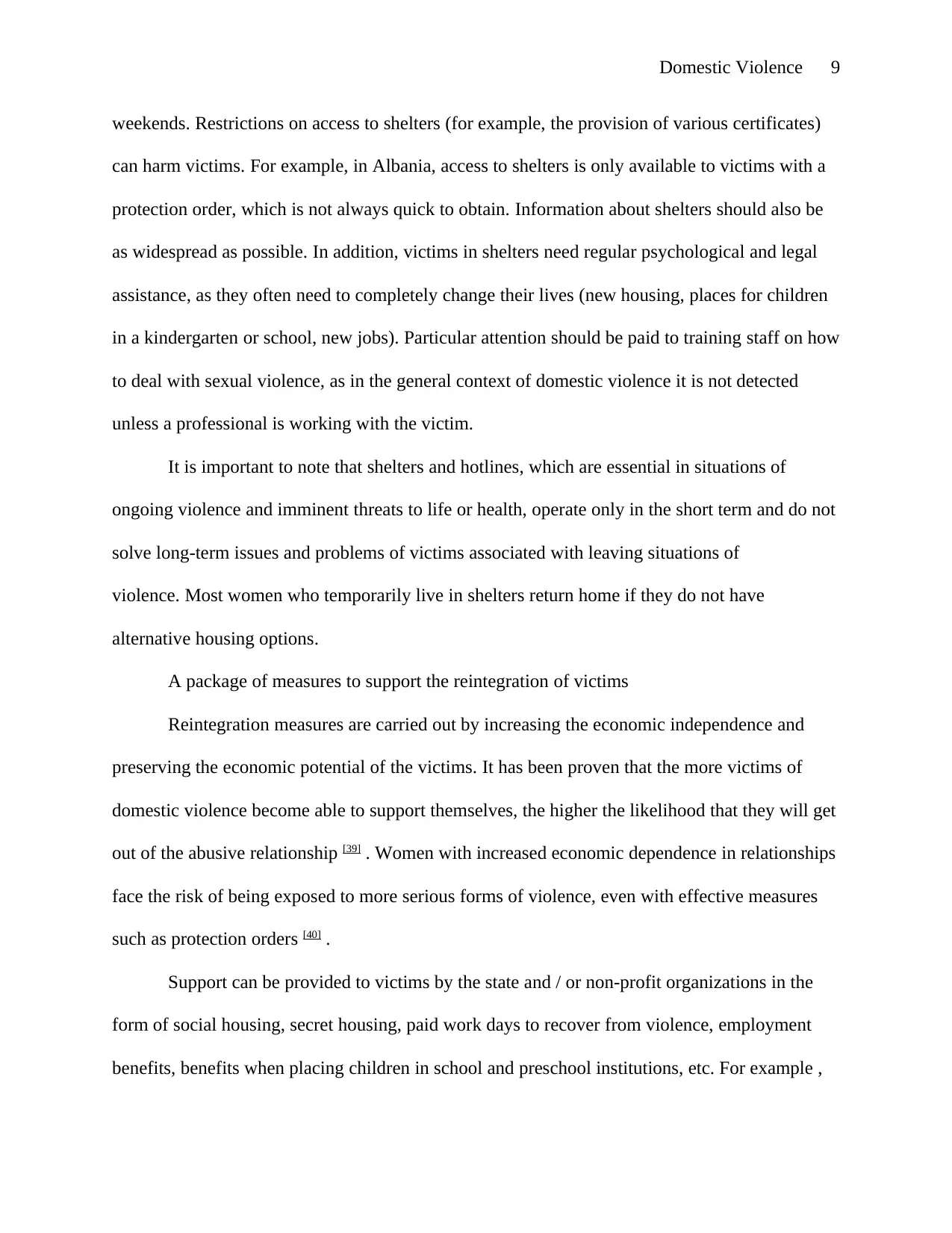
Domestic Violence 9
weekends. Restrictions on access to shelters (for example, the provision of various certificates)
can harm victims. For example, in Albania, access to shelters is only available to victims with a
protection order, which is not always quick to obtain. Information about shelters should also be
as widespread as possible. In addition, victims in shelters need regular psychological and legal
assistance, as they often need to completely change their lives (new housing, places for children
in a kindergarten or school, new jobs). Particular attention should be paid to training staff on how
to deal with sexual violence, as in the general context of domestic violence it is not detected
unless a professional is working with the victim.
It is important to note that shelters and hotlines, which are essential in situations of
ongoing violence and imminent threats to life or health, operate only in the short term and do not
solve long-term issues and problems of victims associated with leaving situations of
violence. Most women who temporarily live in shelters return home if they do not have
alternative housing options.
A package of measures to support the reintegration of victims
Reintegration measures are carried out by increasing the economic independence and
preserving the economic potential of the victims. It has been proven that the more victims of
domestic violence become able to support themselves, the higher the likelihood that they will get
out of the abusive relationship [39] . Women with increased economic dependence in relationships
face the risk of being exposed to more serious forms of violence, even with effective measures
such as protection orders [40] .
Support can be provided to victims by the state and / or non-profit organizations in the
form of social housing, secret housing, paid work days to recover from violence, employment
benefits, benefits when placing children in school and preschool institutions, etc. For example ,
weekends. Restrictions on access to shelters (for example, the provision of various certificates)
can harm victims. For example, in Albania, access to shelters is only available to victims with a
protection order, which is not always quick to obtain. Information about shelters should also be
as widespread as possible. In addition, victims in shelters need regular psychological and legal
assistance, as they often need to completely change their lives (new housing, places for children
in a kindergarten or school, new jobs). Particular attention should be paid to training staff on how
to deal with sexual violence, as in the general context of domestic violence it is not detected
unless a professional is working with the victim.
It is important to note that shelters and hotlines, which are essential in situations of
ongoing violence and imminent threats to life or health, operate only in the short term and do not
solve long-term issues and problems of victims associated with leaving situations of
violence. Most women who temporarily live in shelters return home if they do not have
alternative housing options.
A package of measures to support the reintegration of victims
Reintegration measures are carried out by increasing the economic independence and
preserving the economic potential of the victims. It has been proven that the more victims of
domestic violence become able to support themselves, the higher the likelihood that they will get
out of the abusive relationship [39] . Women with increased economic dependence in relationships
face the risk of being exposed to more serious forms of violence, even with effective measures
such as protection orders [40] .
Support can be provided to victims by the state and / or non-profit organizations in the
form of social housing, secret housing, paid work days to recover from violence, employment
benefits, benefits when placing children in school and preschool institutions, etc. For example ,

Domestic Violence 10
in Portugal, provisions on the response of businesses to cases of domestic violence were
introduced into the labor code - this is the provision of leave for the period of health recovery,
the transfer of the victim to work in branches in other localities of the country, etc.
In Georgia, state crisis centers offer knowledge and skills development programs for the
victims who are in them. The purpose of these programs is to enable them to find work and live
an independent life after they leave the shelter.
Societal responses to women
Alongside the penal response to violence against women, actions are being taken to
identify and support women victims of violence. Information campaigns are regularly carried
out, and from March 2007 a single telephone number for victims or witnesses of domestic
violence was set up: 3919 , which is still effective.
The "serious hazard phones" , mobile with a direct button to call for help in an
emergency, enabled over 400 interventions of the police in 2018.
An online reporting platform(new window), available 24 hours a day, 7 days a week, was
also created to allow victims to communicate anonymously with a police officer or a gendarme
trained in sexual and domestic violence. It also makes it possible to collect witness reports.
Likewise, in order to welcome and support women victims of violence, accommodation
structures have been set up, and the law of 5 March 2007 relating to the right to housing is
enforceable.(new window) (known as the “Dalo law”) provides that women victims of violence
are among the priority groups for the allocation of social housing.
The law of March 7, 2016(new window) facilitates the access of foreign women victims
of violence to a residence permit.
in Portugal, provisions on the response of businesses to cases of domestic violence were
introduced into the labor code - this is the provision of leave for the period of health recovery,
the transfer of the victim to work in branches in other localities of the country, etc.
In Georgia, state crisis centers offer knowledge and skills development programs for the
victims who are in them. The purpose of these programs is to enable them to find work and live
an independent life after they leave the shelter.
Societal responses to women
Alongside the penal response to violence against women, actions are being taken to
identify and support women victims of violence. Information campaigns are regularly carried
out, and from March 2007 a single telephone number for victims or witnesses of domestic
violence was set up: 3919 , which is still effective.
The "serious hazard phones" , mobile with a direct button to call for help in an
emergency, enabled over 400 interventions of the police in 2018.
An online reporting platform(new window), available 24 hours a day, 7 days a week, was
also created to allow victims to communicate anonymously with a police officer or a gendarme
trained in sexual and domestic violence. It also makes it possible to collect witness reports.
Likewise, in order to welcome and support women victims of violence, accommodation
structures have been set up, and the law of 5 March 2007 relating to the right to housing is
enforceable.(new window) (known as the “Dalo law”) provides that women victims of violence
are among the priority groups for the allocation of social housing.
The law of March 7, 2016(new window) facilitates the access of foreign women victims
of violence to a residence permit.
Secure Best Marks with AI Grader
Need help grading? Try our AI Grader for instant feedback on your assignments.
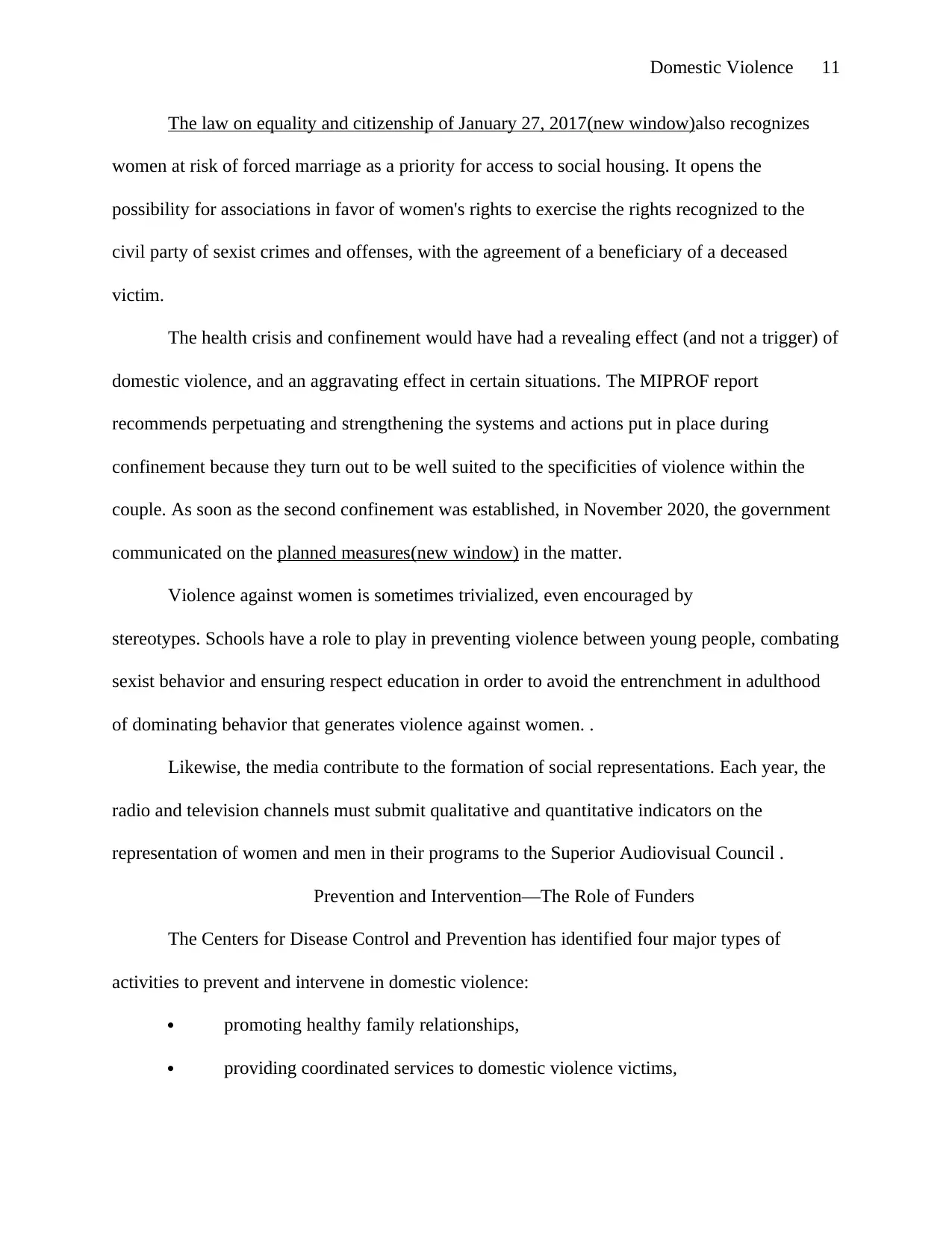
Domestic Violence 11
The law on equality and citizenship of January 27, 2017(new window)also recognizes
women at risk of forced marriage as a priority for access to social housing. It opens the
possibility for associations in favor of women's rights to exercise the rights recognized to the
civil party of sexist crimes and offenses, with the agreement of a beneficiary of a deceased
victim.
The health crisis and confinement would have had a revealing effect (and not a trigger) of
domestic violence, and an aggravating effect in certain situations. The MIPROF report
recommends perpetuating and strengthening the systems and actions put in place during
confinement because they turn out to be well suited to the specificities of violence within the
couple. As soon as the second confinement was established, in November 2020, the government
communicated on the planned measures(new window) in the matter.
Violence against women is sometimes trivialized, even encouraged by
stereotypes. Schools have a role to play in preventing violence between young people, combating
sexist behavior and ensuring respect education in order to avoid the entrenchment in adulthood
of dominating behavior that generates violence against women. .
Likewise, the media contribute to the formation of social representations. Each year, the
radio and television channels must submit qualitative and quantitative indicators on the
representation of women and men in their programs to the Superior Audiovisual Council .
Prevention and Intervention—The Role of Funders
The Centers for Disease Control and Prevention has identified four major types of
activities to prevent and intervene in domestic violence:
promoting healthy family relationships,
providing coordinated services to domestic violence victims,
The law on equality and citizenship of January 27, 2017(new window)also recognizes
women at risk of forced marriage as a priority for access to social housing. It opens the
possibility for associations in favor of women's rights to exercise the rights recognized to the
civil party of sexist crimes and offenses, with the agreement of a beneficiary of a deceased
victim.
The health crisis and confinement would have had a revealing effect (and not a trigger) of
domestic violence, and an aggravating effect in certain situations. The MIPROF report
recommends perpetuating and strengthening the systems and actions put in place during
confinement because they turn out to be well suited to the specificities of violence within the
couple. As soon as the second confinement was established, in November 2020, the government
communicated on the planned measures(new window) in the matter.
Violence against women is sometimes trivialized, even encouraged by
stereotypes. Schools have a role to play in preventing violence between young people, combating
sexist behavior and ensuring respect education in order to avoid the entrenchment in adulthood
of dominating behavior that generates violence against women. .
Likewise, the media contribute to the formation of social representations. Each year, the
radio and television channels must submit qualitative and quantitative indicators on the
representation of women and men in their programs to the Superior Audiovisual Council .
Prevention and Intervention—The Role of Funders
The Centers for Disease Control and Prevention has identified four major types of
activities to prevent and intervene in domestic violence:
promoting healthy family relationships,
providing coordinated services to domestic violence victims,
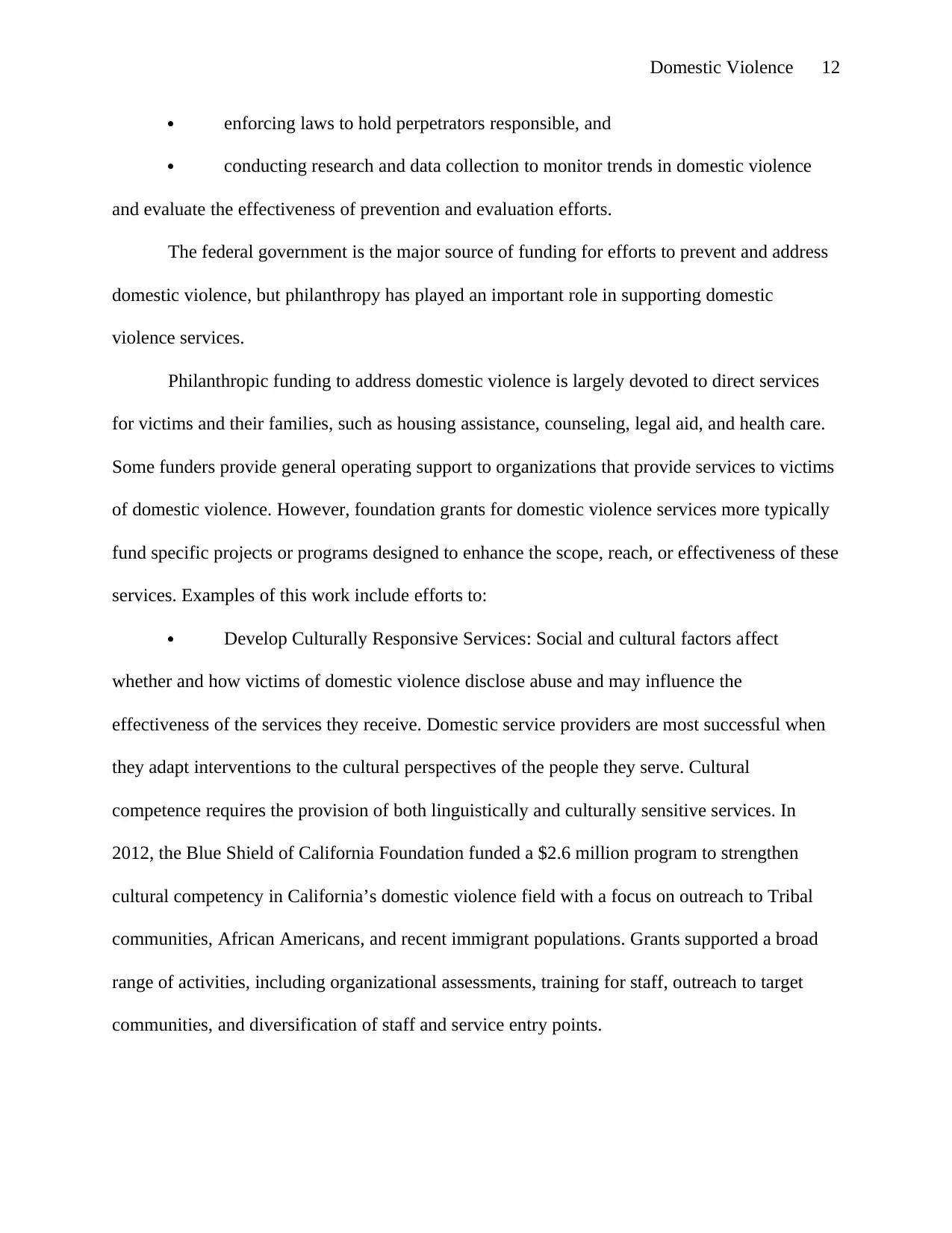
Domestic Violence 12
enforcing laws to hold perpetrators responsible, and
conducting research and data collection to monitor trends in domestic violence
and evaluate the effectiveness of prevention and evaluation efforts.
The federal government is the major source of funding for efforts to prevent and address
domestic violence, but philanthropy has played an important role in supporting domestic
violence services.
Philanthropic funding to address domestic violence is largely devoted to direct services
for victims and their families, such as housing assistance, counseling, legal aid, and health care.
Some funders provide general operating support to organizations that provide services to victims
of domestic violence. However, foundation grants for domestic violence services more typically
fund specific projects or programs designed to enhance the scope, reach, or effectiveness of these
services. Examples of this work include efforts to:
Develop Culturally Responsive Services: Social and cultural factors affect
whether and how victims of domestic violence disclose abuse and may influence the
effectiveness of the services they receive. Domestic service providers are most successful when
they adapt interventions to the cultural perspectives of the people they serve. Cultural
competence requires the provision of both linguistically and culturally sensitive services. In
2012, the Blue Shield of California Foundation funded a $2.6 million program to strengthen
cultural competency in California’s domestic violence field with a focus on outreach to Tribal
communities, African Americans, and recent immigrant populations. Grants supported a broad
range of activities, including organizational assessments, training for staff, outreach to target
communities, and diversification of staff and service entry points.
enforcing laws to hold perpetrators responsible, and
conducting research and data collection to monitor trends in domestic violence
and evaluate the effectiveness of prevention and evaluation efforts.
The federal government is the major source of funding for efforts to prevent and address
domestic violence, but philanthropy has played an important role in supporting domestic
violence services.
Philanthropic funding to address domestic violence is largely devoted to direct services
for victims and their families, such as housing assistance, counseling, legal aid, and health care.
Some funders provide general operating support to organizations that provide services to victims
of domestic violence. However, foundation grants for domestic violence services more typically
fund specific projects or programs designed to enhance the scope, reach, or effectiveness of these
services. Examples of this work include efforts to:
Develop Culturally Responsive Services: Social and cultural factors affect
whether and how victims of domestic violence disclose abuse and may influence the
effectiveness of the services they receive. Domestic service providers are most successful when
they adapt interventions to the cultural perspectives of the people they serve. Cultural
competence requires the provision of both linguistically and culturally sensitive services. In
2012, the Blue Shield of California Foundation funded a $2.6 million program to strengthen
cultural competency in California’s domestic violence field with a focus on outreach to Tribal
communities, African Americans, and recent immigrant populations. Grants supported a broad
range of activities, including organizational assessments, training for staff, outreach to target
communities, and diversification of staff and service entry points.
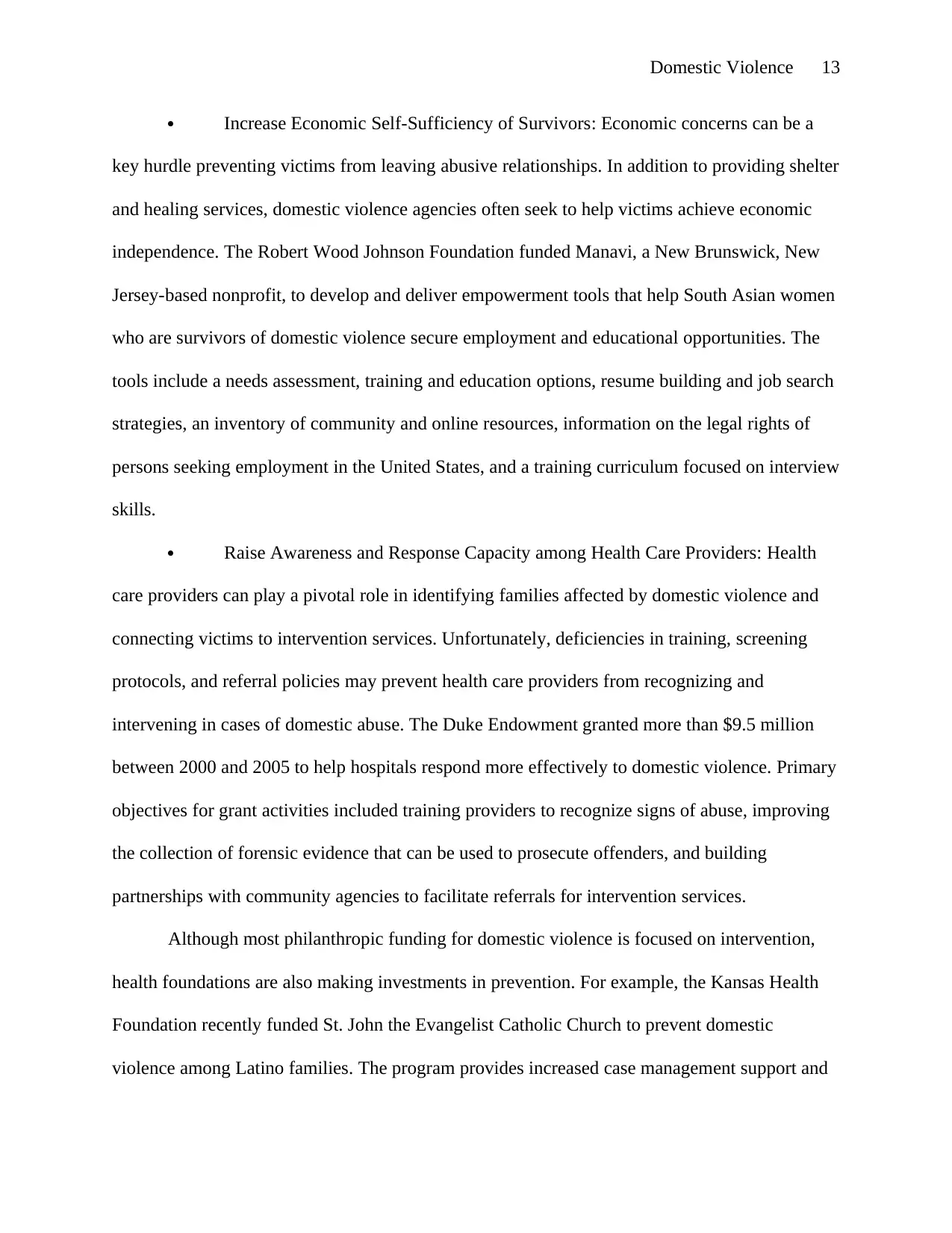
Domestic Violence 13
Increase Economic Self-Sufficiency of Survivors: Economic concerns can be a
key hurdle preventing victims from leaving abusive relationships. In addition to providing shelter
and healing services, domestic violence agencies often seek to help victims achieve economic
independence. The Robert Wood Johnson Foundation funded Manavi, a New Brunswick, New
Jersey-based nonprofit, to develop and deliver empowerment tools that help South Asian women
who are survivors of domestic violence secure employment and educational opportunities. The
tools include a needs assessment, training and education options, resume building and job search
strategies, an inventory of community and online resources, information on the legal rights of
persons seeking employment in the United States, and a training curriculum focused on interview
skills.
Raise Awareness and Response Capacity among Health Care Providers: Health
care providers can play a pivotal role in identifying families affected by domestic violence and
connecting victims to intervention services. Unfortunately, deficiencies in training, screening
protocols, and referral policies may prevent health care providers from recognizing and
intervening in cases of domestic abuse. The Duke Endowment granted more than $9.5 million
between 2000 and 2005 to help hospitals respond more effectively to domestic violence. Primary
objectives for grant activities included training providers to recognize signs of abuse, improving
the collection of forensic evidence that can be used to prosecute offenders, and building
partnerships with community agencies to facilitate referrals for intervention services.
Although most philanthropic funding for domestic violence is focused on intervention,
health foundations are also making investments in prevention. For example, the Kansas Health
Foundation recently funded St. John the Evangelist Catholic Church to prevent domestic
violence among Latino families. The program provides increased case management support and
Increase Economic Self-Sufficiency of Survivors: Economic concerns can be a
key hurdle preventing victims from leaving abusive relationships. In addition to providing shelter
and healing services, domestic violence agencies often seek to help victims achieve economic
independence. The Robert Wood Johnson Foundation funded Manavi, a New Brunswick, New
Jersey-based nonprofit, to develop and deliver empowerment tools that help South Asian women
who are survivors of domestic violence secure employment and educational opportunities. The
tools include a needs assessment, training and education options, resume building and job search
strategies, an inventory of community and online resources, information on the legal rights of
persons seeking employment in the United States, and a training curriculum focused on interview
skills.
Raise Awareness and Response Capacity among Health Care Providers: Health
care providers can play a pivotal role in identifying families affected by domestic violence and
connecting victims to intervention services. Unfortunately, deficiencies in training, screening
protocols, and referral policies may prevent health care providers from recognizing and
intervening in cases of domestic abuse. The Duke Endowment granted more than $9.5 million
between 2000 and 2005 to help hospitals respond more effectively to domestic violence. Primary
objectives for grant activities included training providers to recognize signs of abuse, improving
the collection of forensic evidence that can be used to prosecute offenders, and building
partnerships with community agencies to facilitate referrals for intervention services.
Although most philanthropic funding for domestic violence is focused on intervention,
health foundations are also making investments in prevention. For example, the Kansas Health
Foundation recently funded St. John the Evangelist Catholic Church to prevent domestic
violence among Latino families. The program provides increased case management support and
Paraphrase This Document
Need a fresh take? Get an instant paraphrase of this document with our AI Paraphraser
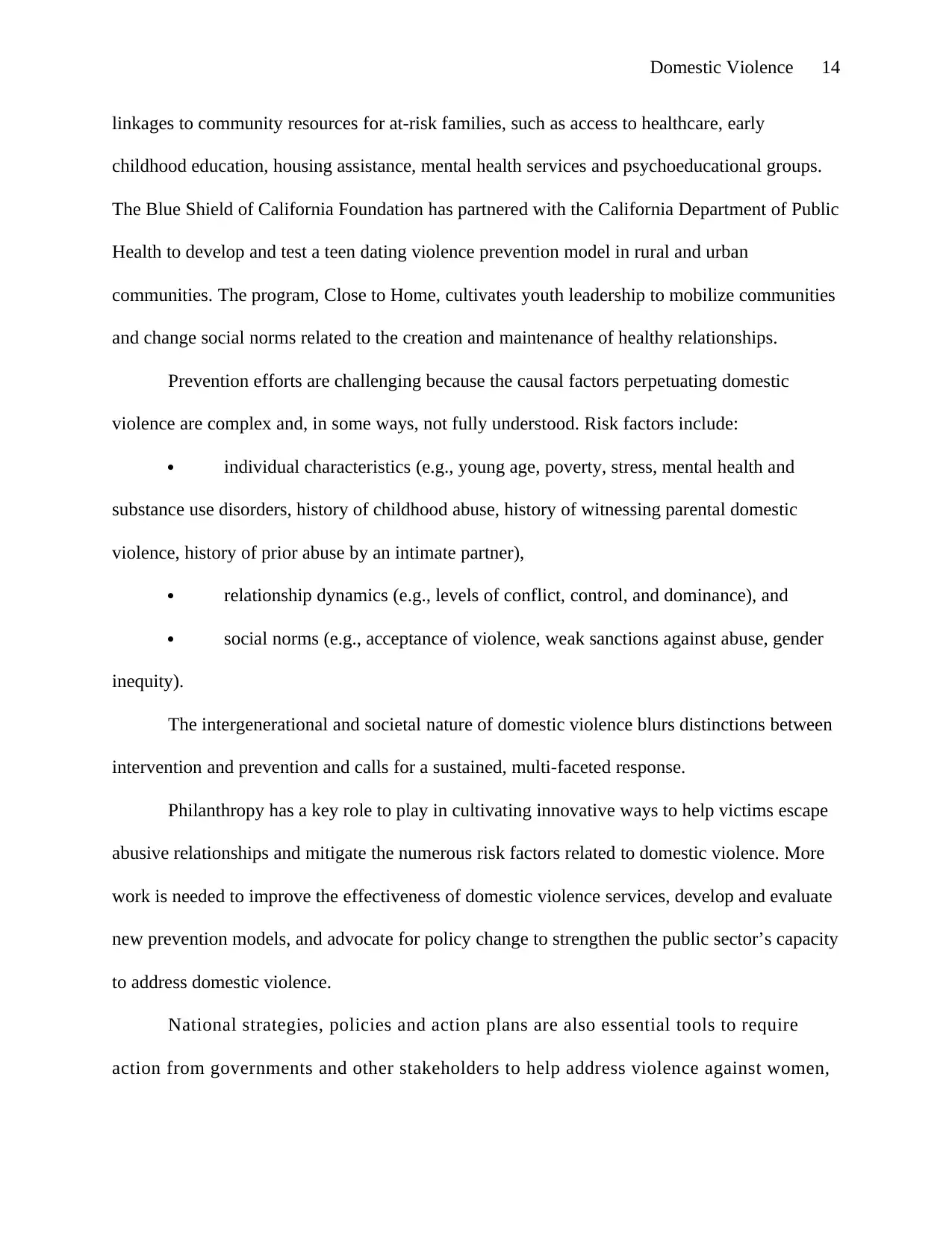
Domestic Violence 14
linkages to community resources for at-risk families, such as access to healthcare, early
childhood education, housing assistance, mental health services and psychoeducational groups.
The Blue Shield of California Foundation has partnered with the California Department of Public
Health to develop and test a teen dating violence prevention model in rural and urban
communities. The program, Close to Home, cultivates youth leadership to mobilize communities
and change social norms related to the creation and maintenance of healthy relationships.
Prevention efforts are challenging because the causal factors perpetuating domestic
violence are complex and, in some ways, not fully understood. Risk factors include:
individual characteristics (e.g., young age, poverty, stress, mental health and
substance use disorders, history of childhood abuse, history of witnessing parental domestic
violence, history of prior abuse by an intimate partner),
relationship dynamics (e.g., levels of conflict, control, and dominance), and
social norms (e.g., acceptance of violence, weak sanctions against abuse, gender
inequity).
The intergenerational and societal nature of domestic violence blurs distinctions between
intervention and prevention and calls for a sustained, multi-faceted response.
Philanthropy has a key role to play in cultivating innovative ways to help victims escape
abusive relationships and mitigate the numerous risk factors related to domestic violence. More
work is needed to improve the effectiveness of domestic violence services, develop and evaluate
new prevention models, and advocate for policy change to strengthen the public sector’s capacity
to address domestic violence.
National strategies, policies and action plans are also essential tools to require
action from governments and other stakeholders to help address violence against women,
linkages to community resources for at-risk families, such as access to healthcare, early
childhood education, housing assistance, mental health services and psychoeducational groups.
The Blue Shield of California Foundation has partnered with the California Department of Public
Health to develop and test a teen dating violence prevention model in rural and urban
communities. The program, Close to Home, cultivates youth leadership to mobilize communities
and change social norms related to the creation and maintenance of healthy relationships.
Prevention efforts are challenging because the causal factors perpetuating domestic
violence are complex and, in some ways, not fully understood. Risk factors include:
individual characteristics (e.g., young age, poverty, stress, mental health and
substance use disorders, history of childhood abuse, history of witnessing parental domestic
violence, history of prior abuse by an intimate partner),
relationship dynamics (e.g., levels of conflict, control, and dominance), and
social norms (e.g., acceptance of violence, weak sanctions against abuse, gender
inequity).
The intergenerational and societal nature of domestic violence blurs distinctions between
intervention and prevention and calls for a sustained, multi-faceted response.
Philanthropy has a key role to play in cultivating innovative ways to help victims escape
abusive relationships and mitigate the numerous risk factors related to domestic violence. More
work is needed to improve the effectiveness of domestic violence services, develop and evaluate
new prevention models, and advocate for policy change to strengthen the public sector’s capacity
to address domestic violence.
National strategies, policies and action plans are also essential tools to require
action from governments and other stakeholders to help address violence against women,
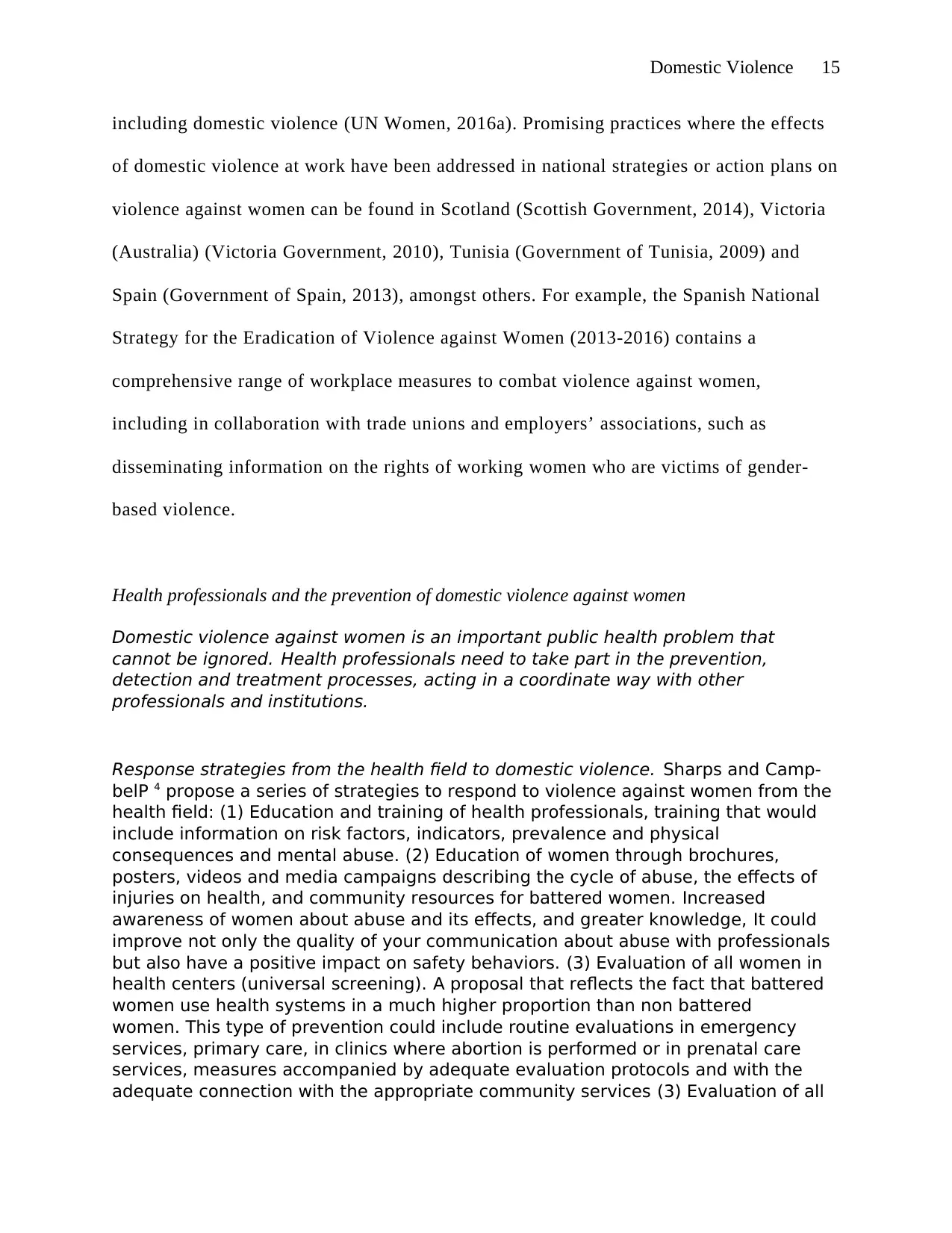
Domestic Violence 15
including domestic violence (UN Women, 2016a). Promising practices where the effects
of domestic violence at work have been addressed in national strategies or action plans on
violence against women can be found in Scotland (Scottish Government, 2014), Victoria
(Australia) (Victoria Government, 2010), Tunisia (Government of Tunisia, 2009) and
Spain (Government of Spain, 2013), amongst others. For example, the Spanish National
Strategy for the Eradication of Violence against Women (2013-2016) contains a
comprehensive range of workplace measures to combat violence against women,
including in collaboration with trade unions and employers’ associations, such as
disseminating information on the rights of working women who are victims of gender-
based violence.
Health professionals and the prevention of domestic violence against women
Domestic violence against women is an important public health problem that
cannot be ignored. Health professionals need to take part in the prevention,
detection and treatment processes, acting in a coordinate way with other
professionals and institutions.
Response strategies from the health field to domestic violence. Sharps and Camp-
belP 4 propose a series of strategies to respond to violence against women from the
health field: (1) Education and training of health professionals, training that would
include information on risk factors, indicators, prevalence and physical
consequences and mental abuse. (2) Education of women through brochures,
posters, videos and media campaigns describing the cycle of abuse, the effects of
injuries on health, and community resources for battered women. Increased
awareness of women about abuse and its effects, and greater knowledge, It could
improve not only the quality of your communication about abuse with professionals
but also have a positive impact on safety behaviors. (3) Evaluation of all women in
health centers (universal screening). A proposal that reflects the fact that battered
women use health systems in a much higher proportion than non battered
women. This type of prevention could include routine evaluations in emergency
services, primary care, in clinics where abortion is performed or in prenatal care
services, measures accompanied by adequate evaluation protocols and with the
adequate connection with the appropriate community services (3) Evaluation of all
including domestic violence (UN Women, 2016a). Promising practices where the effects
of domestic violence at work have been addressed in national strategies or action plans on
violence against women can be found in Scotland (Scottish Government, 2014), Victoria
(Australia) (Victoria Government, 2010), Tunisia (Government of Tunisia, 2009) and
Spain (Government of Spain, 2013), amongst others. For example, the Spanish National
Strategy for the Eradication of Violence against Women (2013-2016) contains a
comprehensive range of workplace measures to combat violence against women,
including in collaboration with trade unions and employers’ associations, such as
disseminating information on the rights of working women who are victims of gender-
based violence.
Health professionals and the prevention of domestic violence against women
Domestic violence against women is an important public health problem that
cannot be ignored. Health professionals need to take part in the prevention,
detection and treatment processes, acting in a coordinate way with other
professionals and institutions.
Response strategies from the health field to domestic violence. Sharps and Camp-
belP 4 propose a series of strategies to respond to violence against women from the
health field: (1) Education and training of health professionals, training that would
include information on risk factors, indicators, prevalence and physical
consequences and mental abuse. (2) Education of women through brochures,
posters, videos and media campaigns describing the cycle of abuse, the effects of
injuries on health, and community resources for battered women. Increased
awareness of women about abuse and its effects, and greater knowledge, It could
improve not only the quality of your communication about abuse with professionals
but also have a positive impact on safety behaviors. (3) Evaluation of all women in
health centers (universal screening). A proposal that reflects the fact that battered
women use health systems in a much higher proportion than non battered
women. This type of prevention could include routine evaluations in emergency
services, primary care, in clinics where abortion is performed or in prenatal care
services, measures accompanied by adequate evaluation protocols and with the
adequate connection with the appropriate community services (3) Evaluation of all
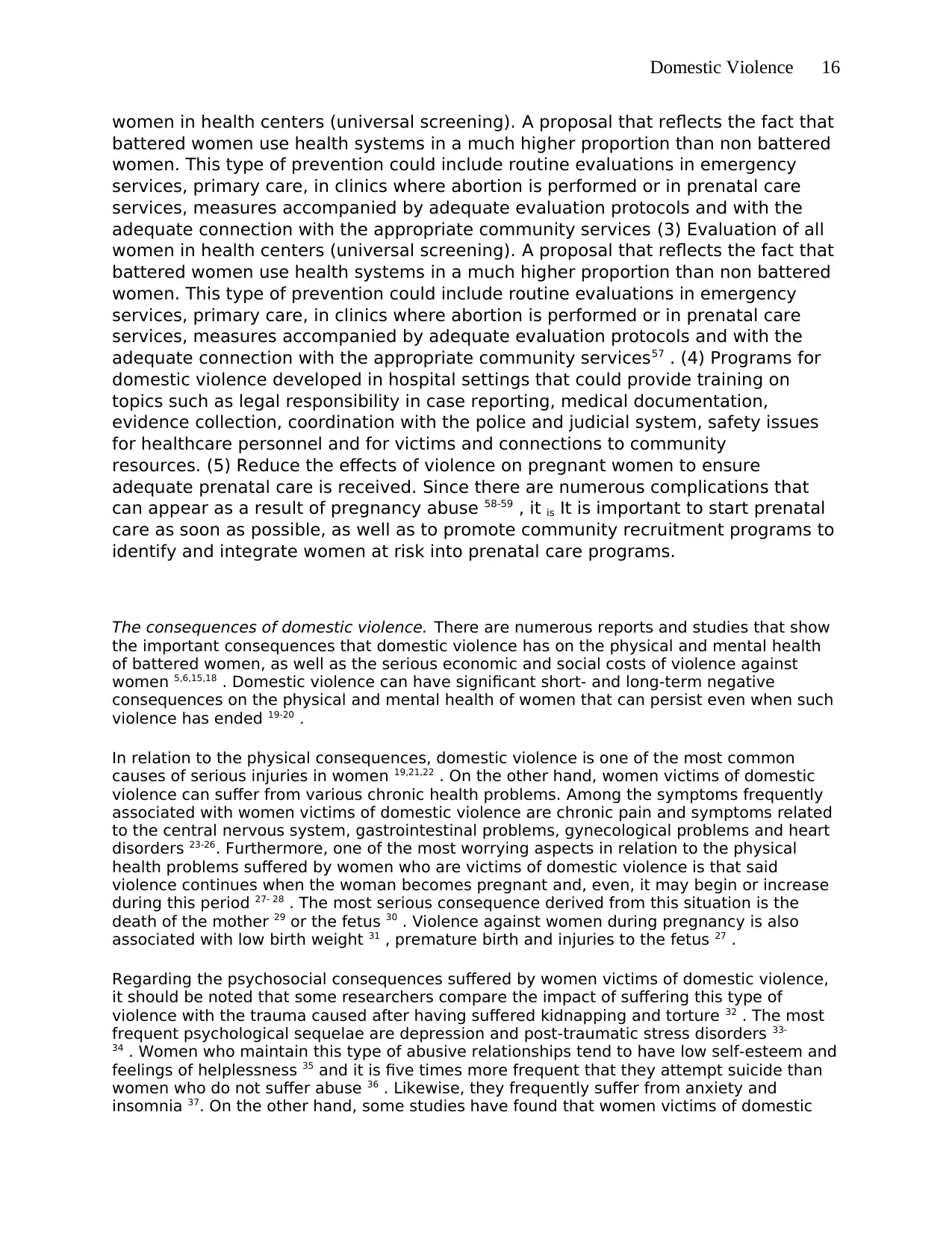
Domestic Violence 16
women in health centers (universal screening). A proposal that reflects the fact that
battered women use health systems in a much higher proportion than non battered
women. This type of prevention could include routine evaluations in emergency
services, primary care, in clinics where abortion is performed or in prenatal care
services, measures accompanied by adequate evaluation protocols and with the
adequate connection with the appropriate community services (3) Evaluation of all
women in health centers (universal screening). A proposal that reflects the fact that
battered women use health systems in a much higher proportion than non battered
women. This type of prevention could include routine evaluations in emergency
services, primary care, in clinics where abortion is performed or in prenatal care
services, measures accompanied by adequate evaluation protocols and with the
adequate connection with the appropriate community services57 . (4) Programs for
domestic violence developed in hospital settings that could provide training on
topics such as legal responsibility in case reporting, medical documentation,
evidence collection, coordination with the police and judicial system, safety issues
for healthcare personnel and for victims and connections to community
resources. (5) Reduce the effects of violence on pregnant women to ensure
adequate prenatal care is received. Since there are numerous complications that
can appear as a result of pregnancy abuse 58-59 , it is It is important to start prenatal
care as soon as possible, as well as to promote community recruitment programs to
identify and integrate women at risk into prenatal care programs.
The consequences of domestic violence. There are numerous reports and studies that show
the important consequences that domestic violence has on the physical and mental health
of battered women, as well as the serious economic and social costs of violence against
women 5,6,15,18 . Domestic violence can have significant short- and long-term negative
consequences on the physical and mental health of women that can persist even when such
violence has ended 19-20 .
In relation to the physical consequences, domestic violence is one of the most common
causes of serious injuries in women 19,21,22 . On the other hand, women victims of domestic
violence can suffer from various chronic health problems. Among the symptoms frequently
associated with women victims of domestic violence are chronic pain and symptoms related
to the central nervous system, gastrointestinal problems, gynecological problems and heart
disorders 23-26. Furthermore, one of the most worrying aspects in relation to the physical
health problems suffered by women who are victims of domestic violence is that said
violence continues when the woman becomes pregnant and, even, it may begin or increase
during this period 27- 28 . The most serious consequence derived from this situation is the
death of the mother 29 or the fetus 30 . Violence against women during pregnancy is also
associated with low birth weight 31 , premature birth and injuries to the fetus 27 .
Regarding the psychosocial consequences suffered by women victims of domestic violence,
it should be noted that some researchers compare the impact of suffering this type of
violence with the trauma caused after having suffered kidnapping and torture 32 . The most
frequent psychological sequelae are depression and post-traumatic stress disorders 33-
34 . Women who maintain this type of abusive relationships tend to have low self-esteem and
feelings of helplessness 35 and it is five times more frequent that they attempt suicide than
women who do not suffer abuse 36 . Likewise, they frequently suffer from anxiety and
insomnia 37. On the other hand, some studies have found that women victims of domestic
women in health centers (universal screening). A proposal that reflects the fact that
battered women use health systems in a much higher proportion than non battered
women. This type of prevention could include routine evaluations in emergency
services, primary care, in clinics where abortion is performed or in prenatal care
services, measures accompanied by adequate evaluation protocols and with the
adequate connection with the appropriate community services (3) Evaluation of all
women in health centers (universal screening). A proposal that reflects the fact that
battered women use health systems in a much higher proportion than non battered
women. This type of prevention could include routine evaluations in emergency
services, primary care, in clinics where abortion is performed or in prenatal care
services, measures accompanied by adequate evaluation protocols and with the
adequate connection with the appropriate community services57 . (4) Programs for
domestic violence developed in hospital settings that could provide training on
topics such as legal responsibility in case reporting, medical documentation,
evidence collection, coordination with the police and judicial system, safety issues
for healthcare personnel and for victims and connections to community
resources. (5) Reduce the effects of violence on pregnant women to ensure
adequate prenatal care is received. Since there are numerous complications that
can appear as a result of pregnancy abuse 58-59 , it is It is important to start prenatal
care as soon as possible, as well as to promote community recruitment programs to
identify and integrate women at risk into prenatal care programs.
The consequences of domestic violence. There are numerous reports and studies that show
the important consequences that domestic violence has on the physical and mental health
of battered women, as well as the serious economic and social costs of violence against
women 5,6,15,18 . Domestic violence can have significant short- and long-term negative
consequences on the physical and mental health of women that can persist even when such
violence has ended 19-20 .
In relation to the physical consequences, domestic violence is one of the most common
causes of serious injuries in women 19,21,22 . On the other hand, women victims of domestic
violence can suffer from various chronic health problems. Among the symptoms frequently
associated with women victims of domestic violence are chronic pain and symptoms related
to the central nervous system, gastrointestinal problems, gynecological problems and heart
disorders 23-26. Furthermore, one of the most worrying aspects in relation to the physical
health problems suffered by women who are victims of domestic violence is that said
violence continues when the woman becomes pregnant and, even, it may begin or increase
during this period 27- 28 . The most serious consequence derived from this situation is the
death of the mother 29 or the fetus 30 . Violence against women during pregnancy is also
associated with low birth weight 31 , premature birth and injuries to the fetus 27 .
Regarding the psychosocial consequences suffered by women victims of domestic violence,
it should be noted that some researchers compare the impact of suffering this type of
violence with the trauma caused after having suffered kidnapping and torture 32 . The most
frequent psychological sequelae are depression and post-traumatic stress disorders 33-
34 . Women who maintain this type of abusive relationships tend to have low self-esteem and
feelings of helplessness 35 and it is five times more frequent that they attempt suicide than
women who do not suffer abuse 36 . Likewise, they frequently suffer from anxiety and
insomnia 37. On the other hand, some studies have found that women victims of domestic
Secure Best Marks with AI Grader
Need help grading? Try our AI Grader for instant feedback on your assignments.

Domestic Violence 17
violence are fifteen times more likely to abuse alcohol and nine times more likely to abuse
other substances 36 .
Bexley Community Safety Partnership
Bexley Community Safety Partnership (BCSP) brings together the authorities responsible for
local crime and disorder strategies. It provides direction, coordination and a partnership response to
deliver activities aimed at reducing crime, disorder and antisocial behaviour.
Bexley Multi-Agency Risk Assessment Conference (MARAC)
A MARAC is a regular local meeting to discuss how to help victims at high risk of
serious harm. MARAC brings together representatives from a number of agencies
in Bexley to discuss the safety, health and well-being of people experiencing
domestic abuse (and their children).
All professionals should have access to a nominated domestic abuse lead who is
trained in completing a domestic abuse stalking, harassment and honour-based
violence risk identification checklist (DASH).
Solace Women’s Aid
In April 2019 Solace Women’s Aid was appointed by the London Borough of
Bexley to provide vital domestic abuse services in the borough.
Solace offers free advice and support to women, children and men in London to
build safe and strong lives. Futures free from abuse and violence.
Their community service will deliver a specialist domestic abuse service that
provides a One-Stop Shop IDVA service for high-risk cases, an outreach service
for media risk cases and resilience-building group programmes. Their aim is that
all women, children and men affected by abuse are given the specialist support
needed to build safer lives and stronger futures.
Solace’s Bexley advocacy and support service (Bexley SASS) provides
support to survivors of domestic abuse residing in the London borough of
violence are fifteen times more likely to abuse alcohol and nine times more likely to abuse
other substances 36 .
Bexley Community Safety Partnership
Bexley Community Safety Partnership (BCSP) brings together the authorities responsible for
local crime and disorder strategies. It provides direction, coordination and a partnership response to
deliver activities aimed at reducing crime, disorder and antisocial behaviour.
Bexley Multi-Agency Risk Assessment Conference (MARAC)
A MARAC is a regular local meeting to discuss how to help victims at high risk of
serious harm. MARAC brings together representatives from a number of agencies
in Bexley to discuss the safety, health and well-being of people experiencing
domestic abuse (and their children).
All professionals should have access to a nominated domestic abuse lead who is
trained in completing a domestic abuse stalking, harassment and honour-based
violence risk identification checklist (DASH).
Solace Women’s Aid
In April 2019 Solace Women’s Aid was appointed by the London Borough of
Bexley to provide vital domestic abuse services in the borough.
Solace offers free advice and support to women, children and men in London to
build safe and strong lives. Futures free from abuse and violence.
Their community service will deliver a specialist domestic abuse service that
provides a One-Stop Shop IDVA service for high-risk cases, an outreach service
for media risk cases and resilience-building group programmes. Their aim is that
all women, children and men affected by abuse are given the specialist support
needed to build safer lives and stronger futures.
Solace’s Bexley advocacy and support service (Bexley SASS) provides
support to survivors of domestic abuse residing in the London borough of
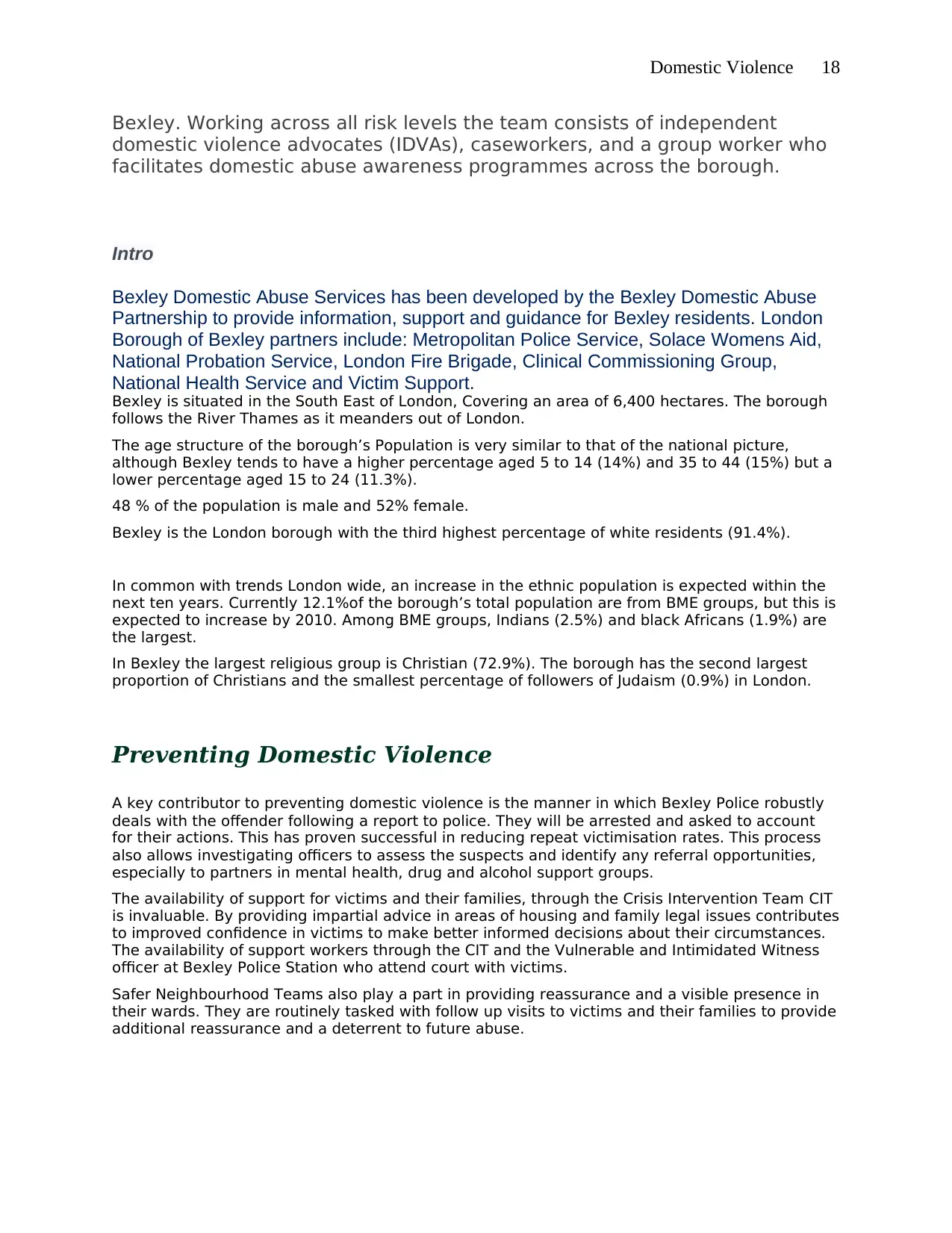
Domestic Violence 18
Bexley. Working across all risk levels the team consists of independent
domestic violence advocates (IDVAs), caseworkers, and a group worker who
facilitates domestic abuse awareness programmes across the borough.
Intro
Bexley Domestic Abuse Services has been developed by the Bexley Domestic Abuse
Partnership to provide information, support and guidance for Bexley residents. London
Borough of Bexley partners include: Metropolitan Police Service, Solace Womens Aid,
National Probation Service, London Fire Brigade, Clinical Commissioning Group,
National Health Service and Victim Support.
Bexley is situated in the South East of London, Covering an area of 6,400 hectares. The borough
follows the River Thames as it meanders out of London.
The age structure of the borough’s Population is very similar to that of the national picture,
although Bexley tends to have a higher percentage aged 5 to 14 (14%) and 35 to 44 (15%) but a
lower percentage aged 15 to 24 (11.3%).
48 % of the population is male and 52% female.
Bexley is the London borough with the third highest percentage of white residents (91.4%).
In common with trends London wide, an increase in the ethnic population is expected within the
next ten years. Currently 12.1%of the borough’s total population are from BME groups, but this is
expected to increase by 2010. Among BME groups, Indians (2.5%) and black Africans (1.9%) are
the largest.
In Bexley the largest religious group is Christian (72.9%). The borough has the second largest
proportion of Christians and the smallest percentage of followers of Judaism (0.9%) in London.
Preventing Domestic Violence
A key contributor to preventing domestic violence is the manner in which Bexley Police robustly
deals with the offender following a report to police. They will be arrested and asked to account
for their actions. This has proven successful in reducing repeat victimisation rates. This process
also allows investigating officers to assess the suspects and identify any referral opportunities,
especially to partners in mental health, drug and alcohol support groups.
The availability of support for victims and their families, through the Crisis Intervention Team CIT
is invaluable. By providing impartial advice in areas of housing and family legal issues contributes
to improved confidence in victims to make better informed decisions about their circumstances.
The availability of support workers through the CIT and the Vulnerable and Intimidated Witness
officer at Bexley Police Station who attend court with victims.
Safer Neighbourhood Teams also play a part in providing reassurance and a visible presence in
their wards. They are routinely tasked with follow up visits to victims and their families to provide
additional reassurance and a deterrent to future abuse.
Bexley. Working across all risk levels the team consists of independent
domestic violence advocates (IDVAs), caseworkers, and a group worker who
facilitates domestic abuse awareness programmes across the borough.
Intro
Bexley Domestic Abuse Services has been developed by the Bexley Domestic Abuse
Partnership to provide information, support and guidance for Bexley residents. London
Borough of Bexley partners include: Metropolitan Police Service, Solace Womens Aid,
National Probation Service, London Fire Brigade, Clinical Commissioning Group,
National Health Service and Victim Support.
Bexley is situated in the South East of London, Covering an area of 6,400 hectares. The borough
follows the River Thames as it meanders out of London.
The age structure of the borough’s Population is very similar to that of the national picture,
although Bexley tends to have a higher percentage aged 5 to 14 (14%) and 35 to 44 (15%) but a
lower percentage aged 15 to 24 (11.3%).
48 % of the population is male and 52% female.
Bexley is the London borough with the third highest percentage of white residents (91.4%).
In common with trends London wide, an increase in the ethnic population is expected within the
next ten years. Currently 12.1%of the borough’s total population are from BME groups, but this is
expected to increase by 2010. Among BME groups, Indians (2.5%) and black Africans (1.9%) are
the largest.
In Bexley the largest religious group is Christian (72.9%). The borough has the second largest
proportion of Christians and the smallest percentage of followers of Judaism (0.9%) in London.
Preventing Domestic Violence
A key contributor to preventing domestic violence is the manner in which Bexley Police robustly
deals with the offender following a report to police. They will be arrested and asked to account
for their actions. This has proven successful in reducing repeat victimisation rates. This process
also allows investigating officers to assess the suspects and identify any referral opportunities,
especially to partners in mental health, drug and alcohol support groups.
The availability of support for victims and their families, through the Crisis Intervention Team CIT
is invaluable. By providing impartial advice in areas of housing and family legal issues contributes
to improved confidence in victims to make better informed decisions about their circumstances.
The availability of support workers through the CIT and the Vulnerable and Intimidated Witness
officer at Bexley Police Station who attend court with victims.
Safer Neighbourhood Teams also play a part in providing reassurance and a visible presence in
their wards. They are routinely tasked with follow up visits to victims and their families to provide
additional reassurance and a deterrent to future abuse.

Domestic Violence 19
Working with victims and communities
The (B)OCU is keen to monitor service user satisfaction and/ or seek feedback from
victims/survivors of domestic and sexual violence and integrate any improvements into policy
and practice.
At the conclusion of a case a SOIT officer sends all victims of serious sexual assaults a
questionnaire. This seeks feedback on the performance of Police throughout the case. Their
comments are scrutinised to ascertain if any feedback can be integrated into good practice. This
is monitored by Central Sapphire to ensure these surveys are handed out. There is also a flag on
the CRIS system (QY) to record compliance. Victims can remain anonymous when completing
questionnaires.
Victim Impact Statements are taken in all cases of serious sexual assault and in domestic
violence cases that are tried at the Crown Court. In Magistrates Court cases the prosecutor
usually addresses the impact on the victim following advice from the Officer in the Case. VIP
Statements are always taken by the assigned SOIT officers and in domestic violence case, the
investigating officer.
The BOCU VCOP Desk ensure that victims are provided with regular updates on cases and
informed quickly of any changes or decisions, although OICs maintain regular contact with their
victims. Within the Sapphire Unit SOITs are responsible for all updates to victims. The Witness
Care Unit is informed by the CPS of any changes to bail conditions and forward these to the OIC
who in turn will inform the victim making whatever risk assessments are necessary.
Four PCSOs and a supervisor staff the VCOP desk. They enter regular updates onto the CRIS at
the commencement of the investigation and throughout the enquiry when contact is made with
the victim. In specific cases such as DV and rape, the SOIT or case officer retains responsibility
for contact although compliance with VCOP is still monitored by the VCOP desk. Regular updates
regarding VCOP compliance is sent to supervisors who must ensure staff remedy any failures.
In the North of the Borough there is a large West African Community and the Safer
Neighbourhood Team have initiated regular Community Meetings with Church elders and
congregations. The intention is to use these meetings to build local links and advisory services
concerning topics such as domestic violence and third party reporting.
Organisational improvement
Bexleyheath was the first Borough to integrate Sapphire, CSU, Misper, ECM and PPG units within
the same location. The liaison between officers, made possible by their co-location, has greatly
contributed to the sharing of information and good practice as well as enhancing performance
figures. This system has now been adopted as good practice by the central CSU and is now policy
MPS wide.
See Annexe A below for more detail on the PPG critical success factors and the VAFOM process
have improved operational performance.
An example of a case where lessons were learnt is as follows:
An Asian female had travelled to London following an arranged marriage and later claimed her
husband and his family had assaulted her. She alleged that they had scratched her arms and
prevented her from leaving the house. She provided a statement and was placed into the care
of her family living in Nottingham to ensure her safety. An officer not attached to the CSU
commenced the investigation on a weekend, at a time when limited resources were available.
Equality and diversity
The CSU DI is a panel member of the Domestic Violence Forum, the Hate Crime Forum, both the
Local Safeguarding Children Board and Safeguarding Adults Executive Committee.
Working with victims and communities
The (B)OCU is keen to monitor service user satisfaction and/ or seek feedback from
victims/survivors of domestic and sexual violence and integrate any improvements into policy
and practice.
At the conclusion of a case a SOIT officer sends all victims of serious sexual assaults a
questionnaire. This seeks feedback on the performance of Police throughout the case. Their
comments are scrutinised to ascertain if any feedback can be integrated into good practice. This
is monitored by Central Sapphire to ensure these surveys are handed out. There is also a flag on
the CRIS system (QY) to record compliance. Victims can remain anonymous when completing
questionnaires.
Victim Impact Statements are taken in all cases of serious sexual assault and in domestic
violence cases that are tried at the Crown Court. In Magistrates Court cases the prosecutor
usually addresses the impact on the victim following advice from the Officer in the Case. VIP
Statements are always taken by the assigned SOIT officers and in domestic violence case, the
investigating officer.
The BOCU VCOP Desk ensure that victims are provided with regular updates on cases and
informed quickly of any changes or decisions, although OICs maintain regular contact with their
victims. Within the Sapphire Unit SOITs are responsible for all updates to victims. The Witness
Care Unit is informed by the CPS of any changes to bail conditions and forward these to the OIC
who in turn will inform the victim making whatever risk assessments are necessary.
Four PCSOs and a supervisor staff the VCOP desk. They enter regular updates onto the CRIS at
the commencement of the investigation and throughout the enquiry when contact is made with
the victim. In specific cases such as DV and rape, the SOIT or case officer retains responsibility
for contact although compliance with VCOP is still monitored by the VCOP desk. Regular updates
regarding VCOP compliance is sent to supervisors who must ensure staff remedy any failures.
In the North of the Borough there is a large West African Community and the Safer
Neighbourhood Team have initiated regular Community Meetings with Church elders and
congregations. The intention is to use these meetings to build local links and advisory services
concerning topics such as domestic violence and third party reporting.
Organisational improvement
Bexleyheath was the first Borough to integrate Sapphire, CSU, Misper, ECM and PPG units within
the same location. The liaison between officers, made possible by their co-location, has greatly
contributed to the sharing of information and good practice as well as enhancing performance
figures. This system has now been adopted as good practice by the central CSU and is now policy
MPS wide.
See Annexe A below for more detail on the PPG critical success factors and the VAFOM process
have improved operational performance.
An example of a case where lessons were learnt is as follows:
An Asian female had travelled to London following an arranged marriage and later claimed her
husband and his family had assaulted her. She alleged that they had scratched her arms and
prevented her from leaving the house. She provided a statement and was placed into the care
of her family living in Nottingham to ensure her safety. An officer not attached to the CSU
commenced the investigation on a weekend, at a time when limited resources were available.
Equality and diversity
The CSU DI is a panel member of the Domestic Violence Forum, the Hate Crime Forum, both the
Local Safeguarding Children Board and Safeguarding Adults Executive Committee.
Paraphrase This Document
Need a fresh take? Get an instant paraphrase of this document with our AI Paraphraser

Domestic Violence 20
Bexley BOCU strives to eradicate unlawful discrimination, promote equality of opportunity and
good community relations. The Borough promotes equal treatment and provision of services for
all, especially those from vulnerable groups or communities such as those affected by domestic
violence, hate crime of any description, mental health issues as well as children and young
persons. We provide a quality policing service to all our communities mindful of the needs of
individuals regardless of their background or status in the community.
Bexley BOCU strives to eradicate unlawful discrimination, promote equality of opportunity and
good community relations. The Borough promotes equal treatment and provision of services for
all, especially those from vulnerable groups or communities such as those affected by domestic
violence, hate crime of any description, mental health issues as well as children and young
persons. We provide a quality policing service to all our communities mindful of the needs of
individuals regardless of their background or status in the community.
1 out of 20
Your All-in-One AI-Powered Toolkit for Academic Success.
+13062052269
info@desklib.com
Available 24*7 on WhatsApp / Email
![[object Object]](/_next/static/media/star-bottom.7253800d.svg)
Unlock your academic potential
© 2024 | Zucol Services PVT LTD | All rights reserved.


